Common menu bar links
Canadian economic accounts
Archived Content
Information identified as archived is provided for reference, research or recordkeeping purposes. It is not subject to the Government of Canada Web Standards and has not been altered or updated since it was archived. Please "contact us" to request a format other than those available.
Real gross domestic product (GDP) increased 0.1% in June, the first monthly increase since July 2008. For the second quarter as a whole real GDP decreased 0.9%, a less pronounced rate of decline than the 1.6% drop in the previous quarter. Final domestic demand increased 0.1% in the second quarter.
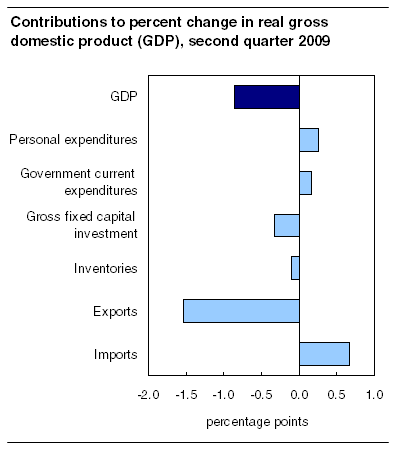
Increased purchases of motor vehicles pushed consumer spending higher in the second quarter, while a rebound in housing resales sparked activity in the residential real estate market. Exports of goods and services and business investment in machinery and equipment were both down, but not as sharply as in the first quarter.
Note to readers
Percentage changes for expenditure-based and industry-based statistics (such as personal expenditures, investment, exports, imports and output) are calculated using volume measures that are adjusted for price variations. Percentage changes for income-based statistics (such as labour income, corporate profits and farm income) are calculated using nominal values, that is, not adjusted for price variations.
The Frequently asked questions section on the National economic accounts module of our website has been updated with a series of questions and answers pertaining to recent economic events and how they are treated within the national economic accounts.
The publication Canadian Economic Accounts Quarterly Review (13-010-X, free) will be published on September 18.
The output of goods-producing industries continued to decline (-3.6%), with the manufacturing and energy sectors being the hardest hit. The service sector increased 0.3% following two consecutive quarterly declines, with the output of real estate agents and brokers contributing the most to the increase.
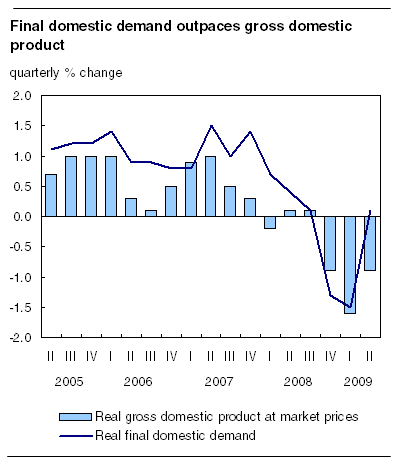
Real GDP contracted at an annualized rate of 3.4% in the second quarter, compared with a 1.0% decline in the US economy.
Table 1
| Change | Annualized change | Year-over-year change | |
|---|---|---|---|
| % | |||
| First quarter 2008 | -0.2 | -0.7 | 1.7 |
| Second quarter 2008 | 0.1 | 0.3 | 0.7 |
| Third quarter 2008 | 0.1 | 0.4 | 0.3 |
| Fourth quarter 2008 | -0.9 | -3.7 | -1.0 |
| First quarter 2009 | -1.6 | -6.1 | -2.3 |
| Second quarter 2009 | -0.9 | -3.4 | -3.2 |
Consumer spending strengthens
Consumer spending on goods and services advanced 0.4%. Increased spending on durable goods (+1.5%), particularly motor vehicles, contributed to the second quarter gain. Increased spending on financial services, mostly on mutual funds and on stock and bond commissions, contributed to the growth in services (+0.4%).
Housing demand increases
Investment in residential structures increased 1.7% in the second quarter, halting five consecutive quarterly declines. Ownership transfer costs related to housing resale activity rebounded by 40%. This rebound offset a decline in the value of new housing construction. Renovation activity was also up (+2.2%) after weakening throughout most of 2008.
Decline in non-residential capital expenditure moderates
Businesses continued to reduce investment in buildings and engineering projects. However, the decline in engineering structures in the second quarter (-5.6%) was less pronounced than in the first quarter (-8.8%).
Investment fell in almost all categories of business machinery and equipment in the second quarter. Trucks and telecommunications equipment were the exceptions, as businesses increased their expenditures on both, following significant decreases in the previous two quarters. As a result, the 4.3% decline in expenditures on machinery and equipment was not as sharp as the 11% drop in the previous quarter.
Government investment in buildings and engineering projects increased 4.7%, the 11th consecutive quarterly advance.
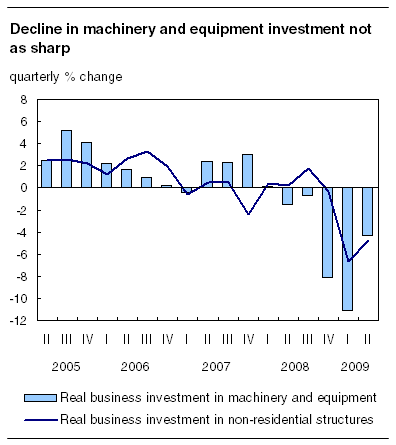
Inventories drawn down again
Inventories were drawn down substantially for a second consecutive quarter. Manufacturers, wholesalers, retailers and farmers all recorded lower inventories in the second quarter.
The economy-wide stock-to-sales ratio edged up to 0.79, equivalent to 72 days of sales, the highest since 1996.
Decline in imports eases
Imports fell 2.2% in the second quarter. This was the fourth quarterly decrease in a row, but was not as steep as in the previous two quarters. Machinery and equipment as well as industrial goods and materials were major contributors to the decline. On the other hand, small increases were recorded in automotive products, "other consumer goods," and agricultural and fish products.
Exports continue to fall
Exports of goods and services dropped 5.2% in the second quarter, after falling 8.7% in the first quarter. Most categories of goods declined, particularly machinery and equipment, industrial goods and materials, and energy products. Exports of services fell 0.3%, after declining substantially in the first quarter.
Economy-wide incomes down slightly
Nominal GDP decreased 0.6% in the quarter, a much slower decline than in the two previous quarters. Corporate profits fell 11%, the third consecutive quarterly double-digit decline. As in the previous two quarters, lower profits were recorded by energy, mining and financial industries. Labour income fell 0.5%. Business sector labour income declined 1.1%, while there was a 1.3% increase in government sector labour income.
Personal income edged up, after falling 0.9% in the first quarter, as Employment Insurance benefits increased 23%. Personal outlays were virtually unchanged from the first quarter, as a drop in personal income taxes helped offset an increase in personal expenditure on goods and services. The saving rate in the personal sector remained at 4.5%.
National saving rate falls again
The national saving rate was 4.4%, its lowest rate since 1994. Both personal and corporate saving rose slightly in the second quarter. Government sector saving (all levels combined) was down for a second consecutive quarter as government revenues continued to decline.
Purchasing power declines
Real gross domestic income (GDI), a measure of Canada's purchasing power, fell 0.5% in the second quarter. The drop in real GDI was less pronounced than the drop in real GDP, as Canada's quarterly terms of trade improved for the first time since the second quarter of 2008. Real GDI was down 8.2% from the second quarter of 2008.
Table 2
| Change | Annualized change | Year-over-year change | |
|---|---|---|---|
| % | |||
| First quarter 2008 | 0.5 | 2.2 | 4.0 |
| Second quarter 2008 | 1.3 | 5.5 | 3.9 |
| Third quarter 2008 | -0.3 | -1.1 | 3.1 |
| Fourth quarter 2008 | -4.3 | -16.0 | -2.7 |
| First quarter 2009 | -3.3 | -12.7 | -6.5 |
| Second quarter 2009 | -0.5 | -2.0 | -8.2 |
Economy-wide prices increase for the first time in three quarters
The price of goods and services produced in Canada increased 0.3%, after declines in the two previous quarters. Excluding energy, prices increased 0.7%. The price of final domestic demand was unchanged.
Gross domestic product by industry, June 2009
Real GDP rose 0.1% in June, after 10 consecutive monthly declines. The output of service industries rose 0.4% in June, the largest increase since the start of the year. Goods-producing industries registered another decline (-0.6%), although it was less pronounced than those of the previous seven months.
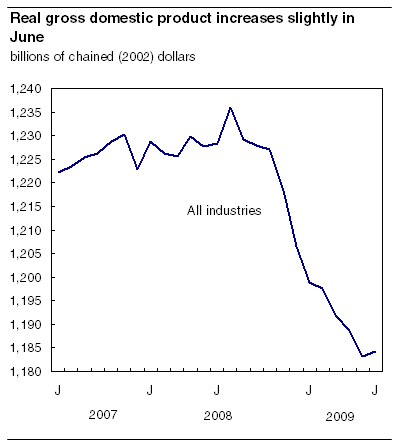
Oil and gas extraction, wholesale trade and real estate agents and brokers were the sectors that contributed the most to the growth of GDP. Retail trade, finance and public administration activities also increased. Decreases in metallic ore mines, manufacturing and, to a lesser extent, construction partly offset these increases.
After three consecutive monthly declines, oil and gas extraction rose 1.3% in June, with both components posting gains. However, extraction of metallic ores, particularly in copper, nickel, lead and zinc mines (-33%), contracted sharply, mainly because of temporary closures attributable to weak demand and maintenance work.
The volume of wholesale trade activities rose 1.3% in June, with most wholesalers recording an increase. Value added in retail trade rose 0.5% in June, following an identical result in May.
The manufacturing sector declined 0.7% in June, with 14 of the 21 major groups contracting. Durable goods manufacturing fell 1.4%, while the manufacturing of non-durable goods advanced 0.1%. The production and processing of non-ferrous metals (except aluminum) decreased sharply (-20%), mainly because of temporary plant closures related to faltering demand.
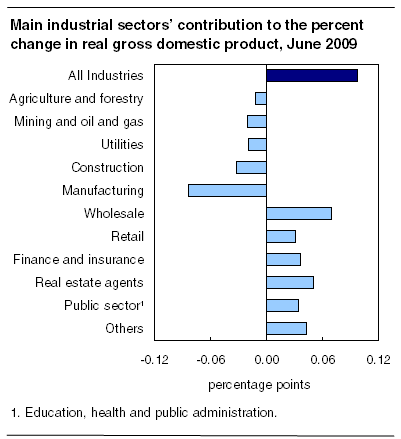
The home resale market made another strong advance, which led to an 8.3% increase in the activities of real estate agents and brokers. However, the construction sector declined 0.5% in June. This drop was mainly attributable to a sizable 1.5% decrease in residential building construction.
Products, services and contact information
Detailed analysis and tables
The National economic accounts module, accessible from the home page of our website, features an up-to-date portrait of national and provincial economies and their structure.
Detailed analysis on today's releases from the national accounts, including additional charts and tables, will soon be available in the second quarter 2009 issue of Canadian Economic Accounts Quarterly Review, Vol. 8, no. 2 (13-010-X, free).
Gross domestic product by industry
Available on CANSIM: table 379-0027.
Definitions, data sources and methods: survey numbers, including related surveys, 1301.
The June 2009 issue of Gross Domestic Product by Industry, Vol. 23, no. 6 (15-001-X, free), is now available from the Publications module of our website.
For more information, or to order data, contact our dissemination officer (613-951-4623; toll-free 1-800-887-4623; iad-info-dci@statcan.gc.ca). To enquire about the concepts, methods or data quality of this release, contact Bernard Lefrançois (613-951-3622), Industry Accounts Division.
Income and expenditure accounts
Available on CANSIM: tables 380-0001 to 380-0017, 380-0019 to 380-0035, 380-0056, 380-0059 to 380-0062, and 382-0006.
Definitions, data sources and methods: survey numbers, including related surveys, 1901 and 2602.
The National Income and Expenditure Accounts: Data Tables (13-019-X, free), and Estimates of Labour Income: Data Tables (13-021-X, free) are also now available from the Publications module of our website.
For more information, or to enquire about the concepts, methods or data quality of this release, consult the Guide to the Income and Expenditure Accounts (13-017-X, free) or contact the information officer (613-951-3640, iead-info-dcrd@statcan.gc.ca), Income and Expenditure Accounts Division.
Table 3
| First quarter 2008 | Second quarter 2008 | Third quarter 2008 | Fourth quarter 2008 | First quarter 2009 | Second quarter 2009 | |
|---|---|---|---|---|---|---|
| Using seasonally adjusted data (2002=100) | ||||||
| quarterly % change | ||||||
| Personal expenditure on consumer goods and services | 0.4 | 0.8 | 0.9 | -0.5 | 0.1 | 0.2 |
| Business gross fixed capital formation | 0.8 | 1.4 | 1.3 | 3.3 | 0.3 | -1.0 |
| Exports of goods and services | 5.8 | 7.4 | 3.1 | -4.1 | -7.1 | -3.3 |
| Imports of goods and services | 3.7 | 3.8 | 4.5 | 5.7 | -1.6 | -4.3 |
| Gross domestic product at market prices | 1.4 | 2.4 | 0.8 | -2.9 | -1.6 | 0.3 |
| Final domestic demand | 0.6 | 1.0 | 1.1 | 0.5 | 0.2 | 0.0 |
Table 4
| First quarter 2008 | Second quarter 2008 | Third quarter 2008 | Fourth quarter 2008 | First quarter 2009 | Second quarter 2009 | |
|---|---|---|---|---|---|---|
| Using seasonally adjusted data (2002=100) | ||||||
| year-over-year % change | ||||||
| Personal expenditure on consumer goods and services | 1.3 | 1.5 | 2.3 | 1.6 | 1.3 | 0.6 |
| Business gross fixed capital formation | 0.5 | 1.8 | 3.2 | 7.1 | 6.5 | 3.9 |
| Exports of goods and services | 1.3 | 10.8 | 17.6 | 12.4 | -1.3 | -11.1 |
| Imports of goods and services | -5.6 | 1.1 | 9.1 | 18.9 | 12.8 | 4.1 |
| Gross domestic product at market prices | 3.5 | 4.9 | 5.8 | 1.6 | -1.3 | -3.4 |
| Final domestic demand | 1.4 | 1.6 | 3.1 | 3.3 | 2.8 | 1.8 |
Table 5
| January 2009r | February 2009r | March 2009r | April 2009r | May 2009r | June 2009p | |
|---|---|---|---|---|---|---|
| Seasonally adjusted | ||||||
| month-to-month % change | ||||||
| All industries | -0.6 | -0.1 | -0.5 | -0.2 | -0.5 | 0.1 |
| Goods-producing industries | -1.8 | -0.7 | -1.7 | -1.1 | -1.6 | -0.6 |
| Service-producing industries | -0.1 | 0.2 | -0.0 | 0.1 | -0.0 | 0.4 |
| Industrial production | -1.9 | -0.8 | -1.9 | -1.3 | -1.8 | -0.6 |
| Manufacturing | -3.2 | -0.8 | -1.3 | -1.2 | -1.9 | -0.7 |
| Wholesale trade | -2.0 | -0.2 | -0.7 | 0.2 | -0.2 | 1.3 |
| Energy sector | -0.1 | 0.0 | -2.7 | -1.7 | -1.7 | 0.9 |
Table 6
| First quarter 2008 | Second quarter 2008 | Third quarter 2008 | Fourth quarter 2008 | First quarter 2009 | Second quarter 2009 | 2007 | 2008 | |
|---|---|---|---|---|---|---|---|---|
| Seasonally adjusted at annual rates | ||||||||
| millions of dollars at current prices | ||||||||
| Gross domestic product by income and by expenditure | ||||||||
| Wages, salaries and supplementary labour income | 812,496 | 820,916 | 827,116 | 831,936 | 824,428 | 820,248 | 784,839 | 823,116 |
| 1.6 | 1.0 | 0.8 | 0.6 | -0.9 | -0.5 | 5.6 | 4.9 | |
| Corporation profits before taxes | 213,056 | 229,532 | 237,708 | 182,900 | 147,508 | 131,168 | 204,131 | 215,799 |
| 2.8 | 7.7 | 3.6 | -23.1 | -19.4 | -11.1 | 4.1 | 5.7 | |
| Interest and miscellaneous investment income | 76,572 | 85,660 | 86,136 | 77,568 | 65,720 | 66,492 | 71,847 | 81,484 |
| 4.0 | 11.9 | 0.6 | -9.9 | -15.3 | 1.2 | 7.7 | 13.4 | |
| Net income of unincorporated business | 93,516 | 95,500 | 97,860 | 98,108 | 96,000 | 97,540 | 90,407 | 96,246 |
| 2.9 | 2.1 | 2.5 | 0.3 | -2.1 | 1.6 | 4.4 | 6.5 | |
| Taxes less subsidies | 164,368 | 166,016 | 166,464 | 163,220 | 159,916 | 161,516 | 166,443 | 165,017 |
| -2.8 | 1.0 | 0.3 | -1.9 | -2.0 | 1.0 | 3.7 | -0.9 | |
| Personal disposable income | 938,832 | 948,596 | 955,512 | 960,852 | 953,256 | 958,648 | 897,562 | 950,948 |
| 2.6 | 1.0 | 0.7 | 0.6 | -0.8 | 0.6 | 5.3 | 5.9 | |
| Personal saving rate2 | 3.3 | 3.4 | 3.1 | 4.9 | 4.5 | 4.5 | 2.5 | 3.7 |
| ... | ... | ... | ... | ... | ... | ... | ... | |
| millions of chained (2002) dollars | ||||||||
| Personal expenditure on consumer goods and services | 810,096 | 812,310 | 813,469 | 807,018 | 804,514 | 808,071 | 787,063 | 810,723 |
| 0.6 | 0.3 | 0.1 | -0.8 | -0.3 | 0.4 | 4.6 | 3.0 | |
| Government current expenditure on goods and services | 261,546 | 264,477 | 264,462 | 266,084 | 267,477 | 269,574 | 254,740 | 264,142 |
| 1.4 | 1.1 | -0.0 | 0.6 | 0.5 | 0.8 | 3.3 | 3.7 | |
| Gross fixed capital formation | 318,328 | 318,118 | 318,616 | 305,999 | 286,570 | 282,381 | 312,482 | 315,265 |
| 0.2 | -0.1 | 0.2 | -4.0 | -6.3 | -1.5 | 3.7 | 0.9 | |
| Investment in inventories | 9,362 | 14,466 | 14,872 | 10,386 | -8,909 | -10,548 | 15,006 | 12,272 |
| ... | ... | ... | ... | ... | ... | ... | ... | |
| Exports of goods and services | 498,552 | 493,352 | 488,152 | 464,964 | 424,701 | 402,504 | 510,323 | 486,255 |
| -0.6 | -1.0 | -1.1 | -4.8 | -8.7 | -5.2 | 1.1 | -4.7 | |
| Imports of goods and services | 585,633 | 589,968 | 584,824 | 547,196 | 483,871 | 473,282 | 572,078 | 576,905 |
| -1.2 | 0.7 | -0.9 | -6.4 | -11.6 | -2.2 | 5.8 | 0.8 | |
| Gross domestic product at market prices | 1,323,013 | 1,324,093 | 1,325,452 | 1,312,880 | 1,292,424 | 1,281,390 | 1,315,907 | 1,321,360 |
| -0.2 | 0.1 | 0.1 | -0.9 | -1.6 | -0.9 | 2.5 | 0.4 | |
| millions of chained (2002) dollars | ||||||||
| Gross domestic product by industry at basic prices | ||||||||
| Goods producing industries | 366,990 | 365,912 | 366,089 | 356,561 | 340,230 | 327,984 | 374,126 | 363,888 |
| -1.1 | -0.3 | 0.0 | -2.6 | -4.6 | -3.6 | 0.5 | -2.7 | |
| Industrial production | 266,931 | 265,380 | 265,103 | 256,531 | 243,656 | 233,575 | 274,908 | 263,486 |
| -1.8 | -0.6 | -0.1 | -3.2 | -5.0 | -4.1 | 0.2 | -4.2 | |
| Energy sector | 83,934 | 82,555 | 83,175 | 82,395 | 80,833 | 77,424 | 85,827 | 83,015 |
| -1.1 | -1.6 | 0.8 | -0.9 | -1.9 | -4.2 | 1.0 | -3.3 | |
| Manufacturing | 178,532 | 178,643 | 176,834 | 168,375 | 156,785 | 150,813 | 185,311 | 175,596 |
| -2.4 | 0.1 | -1.0 | -4.8 | -6.9 | -3.8 | -0.9 | -5.2 | |
| Non-durable manufacturing | 70,615 | 70,783 | 70,169 | 68,116 | 66,360 | 64,498 | 72,507 | 69,921 |
| -1.4 | 0.2 | -0.9 | -2.9 | -2.6 | -2.8 | -1.8 | -3.6 | |
| Durable manufacturing | 108,182 | 108,116 | 106,908 | 100,374 | 90,271 | 86,106 | 113,149 | 105,895 |
| -3.1 | -0.1 | -1.1 | -6.1 | -10.1 | -4.6 | -0.3 | -6.4 | |
| Construction | 74,385 | 74,829 | 75,510 | 74,783 | 71,718 | 70,196 | 72,890 | 74,877 |
| 1.2 | 0.6 | 0.9 | -1.0 | -4.1 | -2.1 | 2.9 | 2.7 | |
| Services producing industries | 862,031 | 864,963 | 867,347 | 863,544 | 859,388 | 861,696 | 846,591 | 864,471 |
| 0.5 | 0.3 | 0.3 | -0.4 | -0.5 | 0.3 | 3.5 | 2.1 | |
| Wholesale trade | 72,012 | 71,682 | 70,929 | 66,964 | 63,686 | 63,668 | 70,256 | 70,397 |
| -0.1 | -0.5 | -1.1 | -5.6 | -4.9 | -0.0 | 5.5 | 0.2 | |
| Retail trade | 74,486 | 74,979 | 75,154 | 73,848 | 73,139 | 73,292 | 72,391 | 74,617 |
| 1.0 | 0.7 | 0.2 | -1.7 | -1.0 | 0.2 | 5.8 | 3.1 | |
| Transportation and warehousing | 56,917 | 57,069 | 56,921 | 56,112 | 55,020 | 54,551 | 56,624 | 56,755 |
| 0.1 | 0.3 | -0.3 | -1.4 | -1.9 | -0.9 | 1.7 | 0.2 | |
| Finance, insurance, real estate and renting | 245,987 | 246,430 | 247,508 | 247,853 | 248,750 | 252,464 | 240,536 | 246,945 |
| 0.8 | 0.2 | 0.4 | 0.1 | 0.4 | 1.5 | 4.0 | 2.7 | |
| Information and communication technologies | 58,333 | 58,758 | 58,997 | 58,738 | 58,256 | 58,087 | 57,199 | 58,707 |
| 0.5 | 0.7 | 0.4 | -0.4 | -0.8 | -0.3 | 4.0 | 2.6 | |

